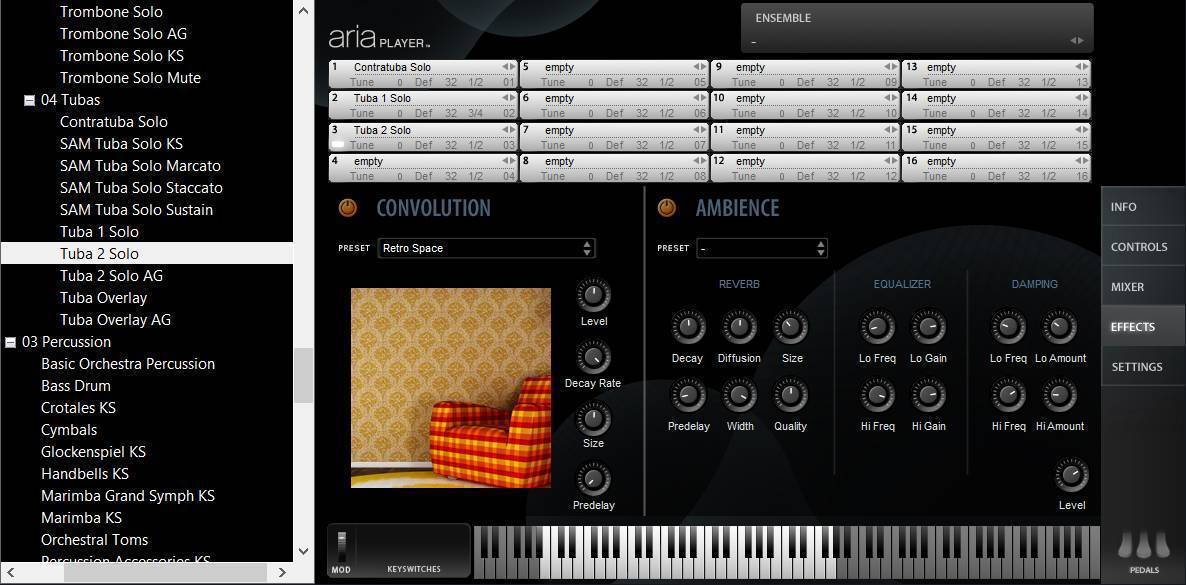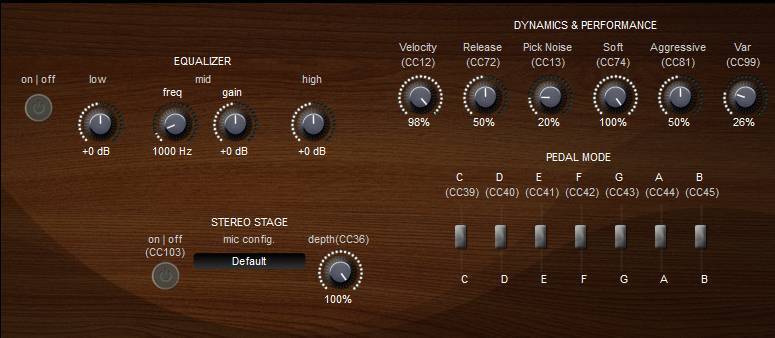Garritan Personal Orchestra 5 ($149.95 or $49.95 upgrade) is a major update of Garritan’s classic orchestral library. It is a 32/64-bit plugin and standalone application for Windows and Mac, and is a complete symphony orchestra.
Taking up approximately 12 GB of disk space, Garritan Personal Orchestra 5 is several times larger than GPO 4 was, but still compact by the standards of orchestral libraries these days. The samples are compressed, so the total raw sample size would be a much larger number if they were WAV files. The instruments are essentially everything that would be found in a modern symphony orchestra – the usual strings, woodwinds, brass, percussion, harps, keyboard instruments and choirs. There aren’t a lot of exotic or unusual instruments – no flugelhorn or cimbasso – though there’s a huge selection of percussion including some pretty rare stuff, a harpsichord, a celesta, and two versions of a glass harmonica. If you don’t know what that is and need to look it up, don’t worry – I had to look it up too, and it’s apparently an instrument that hasn’t been used much since about 1820. The choirs can sing a few different vowels and are quite complete, with men, women, boys and children and even a soprano soloist. There are also various subtle background noises, to add some realistic organic noise and keep recordings from being too clean and perfect, but none of the really distracting ones like coughing, talking, tripping over music stands etc.
One unusual aspect of the library is that while violins or French horns are sampled as a whole section and as solo instruments, there are also samples of individual section players which can be used to build a section of the size that’s needed. These are separate from the solo instrument samples – the solo samples are more expressive and colorful. The strings also have small sections sampled. All this allows the creation of accurate mock-ups of orchestral arrangements for composers or music conservatory students for whom the difference between two trumpets and three trumpets is very important, and who need proper divisi. For them, as well as for producers, it also allows the creation of small ensembles or chamber orchestras for those cases in which a full symphony orchestra would be overkill. I’ve found myself using small string ensembles a lot over the past few weeks, and it’s something that few orchestral libraries have. When adding strings to a pop track, it is very nice to have an intimate ensemble of a size that one might realistically be able to hire for such a project and fit into a small studio if adding strings to a pop song before the era of sample libraries.
As expected, the strings get the largest number of articulations, including FX such as scratches and squeaks, and even the sound of the strings being tuned. Do not expect a whole lot of round robins, velocity layers, and true legato sampling, though – this library is more about being complete while remaining compact and efficient.
The Sound
Most of the instruments are miked pretty close, so the sound is quite dry if no reverb is applied, which is again good for flexibility. The instrument features a built-in impulse reverb module with a nice selection of impulses, including several sizes of concert halls and churches, as well as less orchestral reverbs ranging from small studios to huge cinematic reverbs. Turning on the reverb generally makes the sound much nicer and more pleasant – classical instruments can sound pretty harsh and stark up close. Each impulse comes with a photo, some of which show the actual space where the impulse was captured. Some of you might recognize the specific concert halls and cathedrals in the photos, but I have to include a screenshot of the “retro space”, because it’s the one place where this very serious sample library allowed itself to show a sense of humor.
The sound is mostly middle of the road orchestral, although some of the string and brass variations have a more movie score feel, especially the SAM brass. Things aren’t sampled at extreme dynamics, nor with over the top emotion, so this is not the world’s most epic orchestra. Most of the samples are recorded with some degree of vibrato, though a few instruments also have versions with heavier and lighter vibrato, and sometimes no vibrato at all. So, in essence, you have a small menu of vibrato flavors to choose from, though even the “heavy vibrato” strings are not too cheesy. Only the full-section strings have a “less vibrato” version, though, and the individual instruments and small sections don’t. With any orchestral library, no matter how huge, you always want more, and in this case the first thing I’d like more of is more “less vibrato” strings. In general, you do not get complete and perfect control over each player, but probably about the amount of influence a composer would have over an orchestra with the markings on the score, which fits with the library’s concept and purpose.
One of the four Steinway pianos does take up 1.5 GB of space by itself, making it the single largest instrument in the library, even larger than the organ console which has 12 slots and a choice of 24 stops that can be loaded into those slots. These two, along with the concert grand harp, are probably the most convincing instruments in the library. The instruments which are most capable of flexible, fluid performances in the real world are generally the most difficult to sample, and that also shows here. Although the violins and the trumpets sound very pleasant, getting a realistic-sounding performance out of them is not easy with sustained notes, easier with staccato, and quite easy with pizzicato. The choirs are, of course, also limited compared to a real choir, being unable to sing lyrics, but they actually do sound very nice. The boys’ and children’s choirs sound somewhat unnatural on the very lowest notes, but other than that they actually sound quite nice. They’re really in tune, like a good classical children’s choir on a good day, but not so in tune that they’d sound “too good to be true”. The choirs in general are a very pleasant surprise.
Many of the instruments sampled are really top quality – three different seventeenth century violins being a classic example. The tonal quality of the samples themselves is as good as anything else out there, although the end result won’t sound as realistic as a multi-volume orchestral library that is hundreds of gigabytes in size, of course. GPO works very well for mock-ups of works which are to be performed by a real orchestra, for productions where the orchestral sounds are part of a track, or for lower-budget orchestral productions. For big productions where orchestral sounds are the entire piece, or the core, the library will need to be used in conjunction with some big budget orchestral libraries or real instruments.
The Engine
GPO uses Plogue’s ARIA engine, and can load up to 16 instruments (including non-GPO instruments using the ARIA engine, meaning Sforzando banks such as the free Estate Grand LE, and even the vintage chiptune synth emulations of Chipsounds) which can be assigned to 16 MIDI channels and 16 separate outputs. So, a full orchestral mock-up will take multiple instances, especially if you’re building sections from individual players, but for most other real world uses one instance is plenty. The engine streams samples from disk which keeps RAM usage down, and also doesn’t eat up much CPU. The instrument browser works really well for selecting instruments from the massively long list, too.
Dynamics are controlled in one of two ways. Short sounds such as percussion hits, short string bowings and pizzicato use note velocity only. On the other hand, sustained sounds (including snare rolls) have dynamics controlled by modwheel, while note velocity controls how aggressive the attack is. Moving the modulation wheel around works very well – I can’t hear any phase issues, which means there must be some really interesting things going on in the background to make that work. In addition, each instrument also has some control parameters accessible from the GUI, which vary from instrument to instrument, but generally aren’t too complex. The grand concert harp is as complex as it gets.
The instruments which need legato have scripted legato and portamento, with a great deal of effort put into fine-tuning the curves being used. This can be turned off (so that you can play chords on a flute, for example), and it works reasonably well. It won’t sound like true sampled legato, but it works. Sure, very slow portamento across wide intervals is going to sound blatantly artificial, but including a few intermediate low-velocity notes smooths that out reasonably well. The portamento even works for vaguely Middle Eastern melodies with lots of slides, which is a great “acid test” to expose any bad-sounding portamento. Sure, it’s not as realistic as a real performance would be, but for a track with electronic drums it works perfectly well.
There are no controls that would allow you to go really weird and, for example, put a synth-style resonant filter with LFO-modulated cutoff on the tuba (not without digging in the SFZ files). There is support for loading Scala files with various tunings and temperaments, so even though the instruments are generally more modern, they can play Baroque music using the right scale. In general, GPO sticks to the realm of the realistic, and gets as much as possible out of the samples within that realm.
Summary
Garritan Personal Orchestra 5 is a compact and budget-friendly orchestral library, but a lot more complete and flexible than many much larger and more expensive libraries. It’s an excellent orchestra for the bedroom producer who doesn’t want to spend a lot of money and disk space on orchestra samples. It’s also perfect for academic use, and a powerful tool for the serious orchestral music producer who already owns multiple virtual orchestras and always wants more.
More info: Garritan Personal Orchestra 5 ($149.95)
Garritan Personal Orchestra 5 Review
Garritan Personal Orchestra 5 is a compact and budget-friendly orchestral library, but a lot more complete and flexible than many much larger and more expensive libraries. It's an excellent orchestra for the bedroom producer who doesn't want to spend a lot of money and disk space on orchestra samples.
-
Features8
-
Workflow9
-
Performance10
-
Design9
-
Sound9
-
Pricing10





5 Comments
simbosan
onOne very important feature for me is that it is one of a tiny number of virtual instruments which work properly worth a wind controller. This makes it superb for expressive playing, I find wind controllers sensational in that department.
D. Smolken
onThanks for that information – I don’t have a wind controller so I couldn’t test that.
Roman
onThat glass harp though. Sounds amazing.
D. Smolken
onIt does, though I don’t know how it compares to the real thing – I’ve seen and heard the “wine glasses with various amounts of water” glass harps in real life, but never this big spinning disc type.
C. Harrell
onOne of the coolest uses of the instrument I’m aware of is Nino Rota’s dope-ass score to Casanova.
https://www.youtube.com/watch?v=cn8bQmo-Tw4
https://www.youtube.com/watch?v=4WvvxXIGExo
Thanks for your thorough review! I appreciate that you listed the features in an objective way (like stating the reverb without as strong emphasis as to whether that’s good). It’s much more helpful to have those features listed so a person can see if the program’s suited for their individual needs.